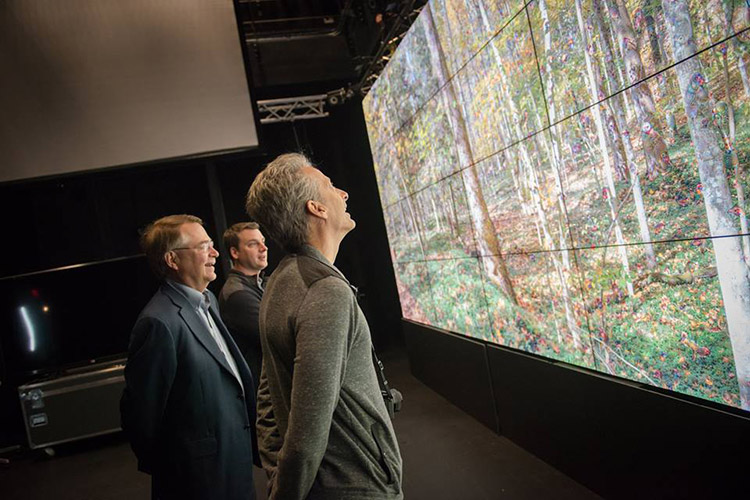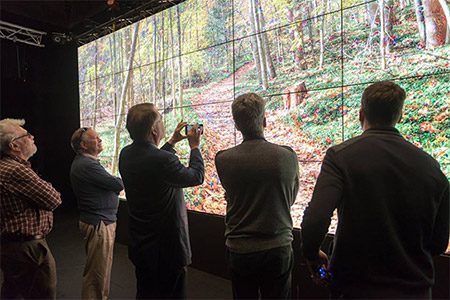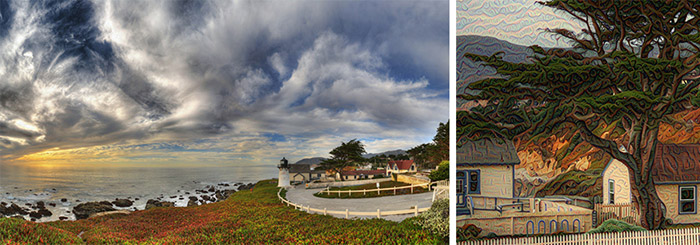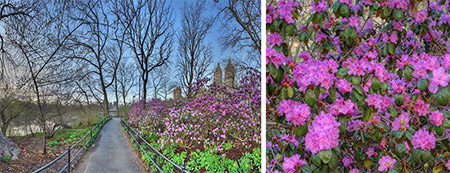
Artist, Software Engineers Showcase ‘Dreamscapes’ on Calit2 Visualization Wall
Published Date
By:
- Doug Ramsey
Share This:
Article Content

Artist Daniel Ambrosi (in front) and Calit2’s Larry Smarr view art work based on computer processing of super-high-resolution landscape image. Photo by Alex Matthews/Qualcomm Institute
On March 31, Calit2 Director Larry Smarr welcomed artist Daniel Ambrosi to Calit2’s Qualcomm Institute on the UC San Diego campus to view Ambrosi’s works of art in an unprecedented way. “It was thrilling to be able to view these new works in their entirety at full resolution for the very first time,” observed the artist behind Dreamscapes series. “By bringing up the digital artworks on the Vroom display system in the Calit2 Theater, the massive display allowed me to see the images at virtually lifelike scale and beyond.” The Vroom system boasts 66 million pixels (megapixels) across 32 high-definition displays arranged in four rows of eight displays each, creating a nearly seamless viewing area eight feet high and 32 feet wide.

Calit2 director Larry Smarr welcomes artist Daniel Ambrosi to view his art works on the 66-million-pixel Vroom display system in Qualcomm Institute. Photo by Alex Matthews/Qualcomm Institute
Tom DeFanti, senior Calit2 research scientist, spent much of the day with Dan showing him the various scalable visualization and virtual reality rooms he and his team have developed at the Qualcomm Institute. “These enormous images are just the sort of technology-enabled art that the large-scale visualization systems at Calit2 were designed for,” said DeFanti. “It was a real pleasure seeing the stunning images Dan had created, while talking to him about the computing details that allowed him to make them.”
The visit to the UC San Diego campus took place just days before Ambrosi was scheduled to go public on the project at the GPU Technology Conference organized by NVIDIA, the largest maker of graphics processing units (GPUs) used for computer graphics and other purposes. The conference takes place April 4-7 in San Jose, and organizers invited Ambrosi and collaborating engineers Chris Lamb from NVIDIA and Google’s Joseph Smarr – the older son of Calit2’s Smarr – to present jointly their project’s workflow and processes in a Tuesday ‘hangout’ session called “Dreaming Big: Scaling Up Deep Dream to Operate on Multi-Hundred Megapixel Images.”
Three of the images will be on display at the conference as eight-foot-tall, backlit, printed panoramas that look like nature from a distance, but which offer richly detailed and wholly unexpected artistic content when viewed up close.
“These scenic displays represent a true collaboration between nature, man and machine,” said Ambrosi. “They combine super-high-resolution, panoramic landscape photographs that were subsequently processed using a modified version of the Deep Dream neural net visualization code open-sourced by Google, which allows the computer to ‘dream’ and change the image based on certain tweakable parameters set by the artist.”

Art work Point Montara Lighthouse (left) with closeup detail. Courtesy: Daniel Ambrosi
Initial attempts to use the Deep Dream code to transform the oversized images fell short because the system was not designed to operate on such unusually large images. “That’s when I turned to Joseph and Chris,” recalled Ambrosi. In their spare time, the engineers worked to modify the Deep Dream code to handle the artist’s panoramas. “It needed to operate on giant, multi-hundred megapixel images without running out of memory or taking an eternity,” noted Joseph Smarr, a senior staff software engineer with Google Photos. “With all the current excitement and anxiety around Artificial Intelligence, Deep Learning and what they mean for society, it was truly exciting to be able to help empower an artistic expression of the beauty that can result from this marriage of art and technology, man and machine.”
Ambrosi starts by capturing high-resolution images at overlapping points for a panorama and at multiple exposures. He stitches together the individual views and blends the exposures to produce each foundational multi-hundred-megapixel image for later processing on NVIDIA GPUs via Amazon’s EC2 cloud processing platform. As described in his Dreaming Big blog, “running this code on NVIDIA GPUs is literally about 10 times faster than CPU only,” observed Google’s Smarr.

Azalea Walk, Central Park, NYC, by Daniel Ambrosi, and image details with feather-like flowers. Courtesy: Daniel Ambrosi
NVIDIA’s Chris Lamb, a senior director of GPU computing software at the company, helped run the artist’s jumbo landscape images on the NVIDIA GPUs. “Each scene took up to 10 hours, performing as many as 90 quadrillion floating-point operations in the process of transforming Daniel’s source images,” said Lamb, who is deeply experienced with NVIDIA’s CUDA parallel computing platform that offers dramatic improvements in computing performance using GPUs. “It was great to experience how easy it is to stand up a compute-intensive CUDA application like this, and the extreme level of detail in each image means that the viewer can examine a resulting image hundreds of times and still find something new and different in the art work on each viewing.”
Attendees at the GPU Technology Conference will get to see three of the GPU-modified panoramas decorating walls of the conference center: super-sized images eight feet by 16 feet each that, from a distance, look like a photograph, but which up-close can be wildly dream-like (based on “dreaming-style” parameters selected by Ambrosi, ranging from abstract/impressionistic to literal/animalistic.) As a result, brightly-colored flower petals can take on the texture of feathers, while trees and ground cover may teem with birds and ground animals that are suggested rather than depicted (see images and closeups).
“I was blown away standing before these unique and quite beautiful computational images, while talking to the artist about what he had achieved,” said Calit2 director Smarr. “Supporting interactions between leading technology companies like NVIDIA, innovative artists like Dan, and deep technical experts like Joseph and Chris is an essential part of Calit2’s DNA.”
“We are all actively participating in a shared waking dream,” observed Ambrosi after showing the Calit2 director a dozen of the art works on the Vroom display system. “Science shows us that our limited senses perceive a tiny fraction of the phenomena that comprise our world. Dreamscapes are my way of reminding myself and others that there is much more going on than meets the eye.”
Share This:
You May Also Like
Stay in the Know
Keep up with all the latest from UC San Diego. Subscribe to the newsletter today.


